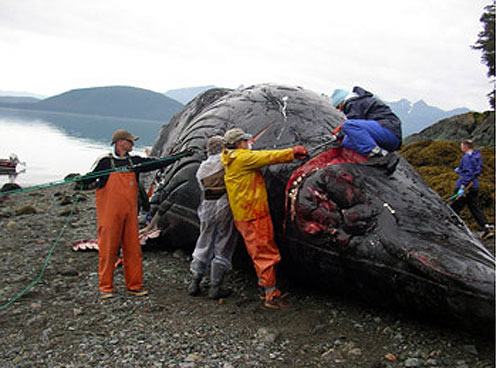 August 05, 2010
Princess Cruises notified the Coast Guard and NOAA Fisheries of the incident, which had likely occurred overnight while the vessel was underway in Chatham Strait. The Sapphire Princess was in Tracy Arm en route to Juneau at the time of the discovery. The whale was removed from the bow of the ship near the end of Douglas Island by a tugboat, towed to shore, and secured for necropsy. 
Scientists found that this was a complex case, as evidence indicated that several events had likely transpired by the time the whale was found on the bow of the cruise ship. Lead veterinarian Dr. Pam Tuomi from the Alaska Sea Life Center and NOAA Fisheries veterinarian Dr. Kate Savage agreed that the most likely scenario may have involved three different events:
The team recovered one of the whale's eyes, which can be used to age the animal. They also collected other samples for further analysis, including skin, muscle, blubber, liver, kidney, ovaries, stomach contents, parasites, urine, and feces, which will be sent to various labs for contaminant analysis, genetics, and indications of exposure to toxins like harmful algal blooms. "Our first priority is to try to determine cause of death," said Aleria Jensen, NOAA Fisheries stranding coordinator for Alaska. "But there is also a tremendous amount we can learn from an animal like this about life history, feeding habits, exposure to toxins, and impacts from human activities. Stranded marine mammals can really be considered sentinels for marine ecosystem health." One such finding was an exam to measure the stomach contents of a fully grown humpback whale. "The whale had basically two things in its stomach-krill and water," said Ron Heintz, a scientist at the Ted Stevens Marine Research Institute in Juneau. "We measured at least 65 gallons of volume." Researchers are also trying to match the markings on the tail fluke of the female humpback to existing photos of whales in Southeast Alaska humpback whale catalogues. The necropsy was conducted under the umbrella of the Alaska Marine Mammal Stranding Network, part of a larger national network which monitors marine mammal health and responds to dead animals and live marine mammals in distress. The Alaska network consists of trained responders which stretch across the state, from Ketchikan to Dutch Harbor to Nome. Activities of the network are authorized by the Marine Mammal Protection Act, and in this case involving a humpback whale, through the Endangered Species Act. Ship strikes with large whales in Alaska appear to be increasing, which may be a result of an increasing population of humpback whales in the North Pacific as well as greater reporting effort. Mariners are urged to slow their speeds when whales are spotted in the vicinity of travel, as well as when traveling in areas of known whale density such as Frederick Sound, Icy Strait, Chatham Strait and Lynn Canal. Vessels are encouraged to post lookouts and to travel with utmost vigilance at night. Mariners are requested to report any sightings of whales in distress to the NOAA Fisheries Marine Mammal Hotline at (877) 925-7773. NOAA Fisheries would like to remind the public that humpback whales are protected by both the Marine Mammal Protection Act (MMPA) and the Endangered Species Act (ESA). Tampering with or removing parts from the carcass is prohibited, and personal possession of any parts from a listed animal is a violation of the Endangered Species Act (ESA).
Related:
Source of News & Photograph:
Publish A Letter in SitNews Read Letters/Opinions
|